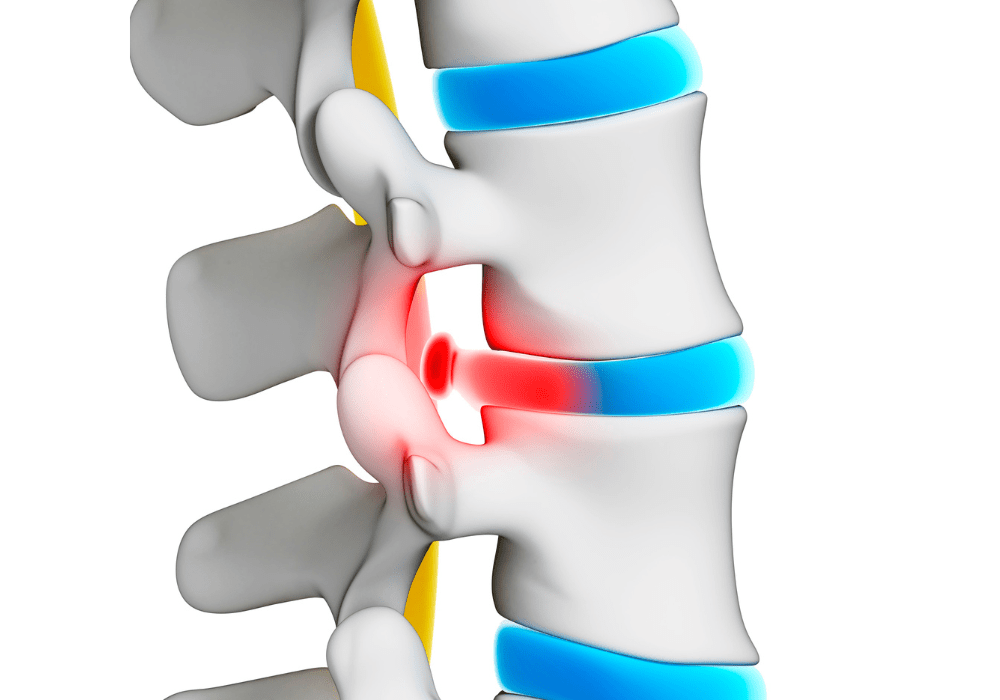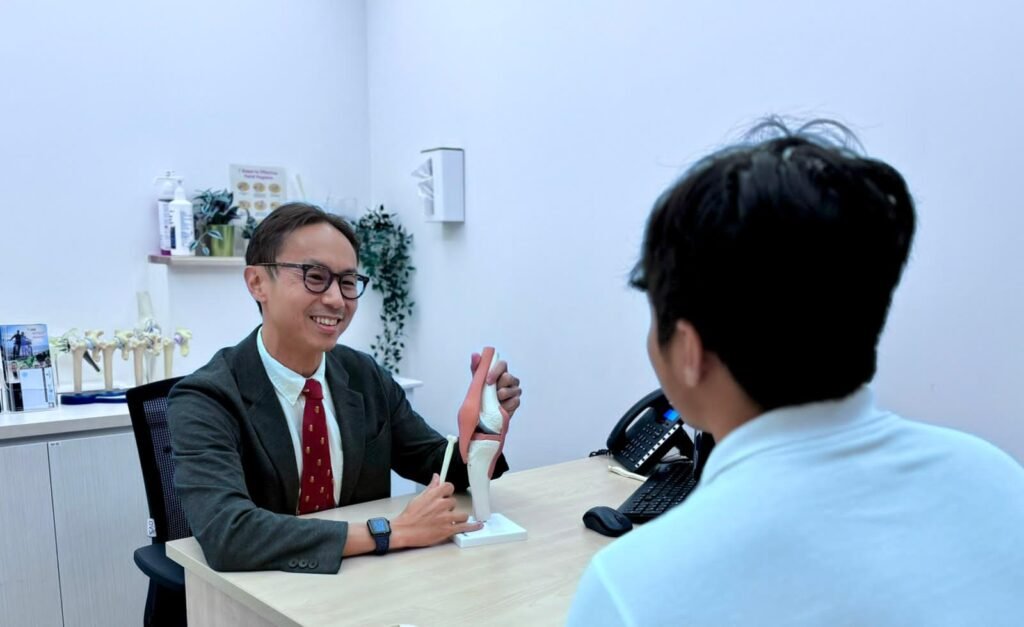A herniated disc, alternatively referred to as a slipped or ruptured disc, happens when a spinal disc tears its tough outer layer, allowing the soft inner core to protrude. The damaged nerves’ service area may experience pain, numbness, or weakening as a result of this ailment. It can be brought on by aging, trauma, or normal wear and tear on the spine and typically affects the neck (cervical spine) or lower back (lumbar spine). Depending on how bad the symptoms are, there are a variety of treatment options available, such as physical therapy, medication, rest, or in extreme situations, surgery.

A herniated disc, alternatively referred to as a slipped or ruptured disc, happens when a spinal disc tears its tough outer layer, allowing the soft inner core to protrude.
A herniated disc is a disorder in which a spinal disc’s soft inner core protrudes through a tear in its tough covering. It is also referred to as a slipped or ruptured disc. Numerous variables may contribute to this. Age is a major factor because, as we age, our spinal discs gradually lose water content and become less flexible, which increases the risk of herniation. The discs’ aging-related degeneration weakens the outer layer even more, raising the possibility of a herniation. The outer layer of the disc may tear or break as a result of trauma or injury to the spine, such as from a fall or auto accident, causing the inner core to protrude. The following factors can individually or collectively predispose someone to developing a herniated disc: obesity, genetics, repetitive activities that stress the spine, smoking, certain occupations that involve heavy lifting or prolonged sitting, and improper lifting techniques, especially when lifting heavy objects with poor body mechanics. These factors can cause strain on the spine and result in a herniated disc.



Depending on where and how severe the herniation is, a herniated disc can cause a variety of symptoms. Typical signs and symptoms include of:
Pain
The intensity of pain varies and can be confined to the region of the herniated disc or extend to other body regions like the arms, legs, or buttocks. Sneezing, coughing, or movement may make the pain worse.
Numbness or tingling
Herniated discs can compress surrounding nerves, causing the affected area to feel numb, tingly, or as if there are pins and needles. Depending on where the herniation occurs, the numbness or tingling may go down the arms or legs.
Weakness
Weakness in the muscles that a herniated disc serves can also result from compression of nerves. The inability to walk, lift, or hold objects, or carry out other tasks requiring muscle power, may be impacted by this disability.
Reflex changes
Herniated discs can sometimes impact reflexes, making them more pronounced or less so.
Sciatica
Sciatica is a condition caused by compression of the sciatic nerve caused by a herniated disc in the lower back. Radiating down the leg, sciatica can induce tingling, numbness, or pain.
Difficulty with bowel or bladder function
People may have trouble urinating or passing gas when a big herniated disc compresses the nerves that regulate bowel or bladder function. This is a medical emergency and needs to be treated urgently
When Surgery is Needed?
In cases where non-surgical therapies are ineffective or when there is severe nerve compression, there is a need for surgery intervention. This can lead to increasing paralysis, loss of sensation, or loss of control over the bowels or bladder, known as cauda equina syndrome.
Let’s explore the surgical options that can help restore mobility and relieve pain in such extreme situations.
Spinal Fusion
Spinal fusion is a common procedure used to treat various spinal conditions such as degenerative disc disease, spondylolisthesis, or significant spinal instability. This surgery involves permanently joining two or more vertebrae, which eliminates movement between them, thus stabilizing the spine and alleviating pain. During the procedure, surgeons use bone grafts (from the patient or a donor) along with metal rods, screws, and cages to fuse the vertebrae. The goal is to create a solid mass of bone over time, providing stability to the spine. While spinal fusion can greatly reduce pain and improve quality of life, it also decreases flexibility in the fused segment, which is a crucial consideration for athletes and active individuals.
Laminectomy
For patients experiencing spinal stenosis or severe nerve compression, a laminectomy can be an effective surgical solution. This procedure involves removing a portion of the vertebral bone called the lamina, which covers the spinal canal. By doing so, surgeons can relieve pressure on the spinal cord and nerves. This relief can significantly reduce symptoms such as pain, numbness, and weakness, often experienced in the legs or arms. Laminectomy can be performed alone or alongside spinal fusion if additional spinal stability is required. This procedure is particularly beneficial for athletes who need to restore their physical capabilities and return to their sports activities.
Discectomy
Herniated discs can be particularly problematic for athletes, leading to severe pain and mobility issues. Discectomy is a targeted surgical procedure that removes the herniated portion of an intervertebral disc pressing on a nerve root or the spinal cord. By alleviating this pressure, discectomy can provide immediate pain relief and improved function. There are minimally invasive versions of this surgery, such as microdiscectomy, which use smaller incisions and result in quicker recovery times—an essential factor for athletes eager to return to their training and competition.
Whether it’s spinal fusion to stabilise the spine, a laminectomy to relieve nerve pressure, or a discectomy to remove a herniated disc, our goal is to help our patients return to their active lifestyles with minimal downtime and maximum results.
The Post Surgical Management
The goals of post-surgical care for a herniated disc are to facilitate healing, reduce pain, regain function, and avoid complications.
Pain control:
Following surgery, pain is common and can be controlled with prescription drugs from your doctor. These include medications that reduce pain, relaxants for the muscles, and anti-inflammatory ones. It’s critical to take prescription drugs as prescribed and to let your healthcare provider know about any adverse effects or concerns.
Physical treatment:
In order to assist the spine and associated muscles regain their strength, flexibility, and range of motion, physical therapy is frequently advised. A physical therapist will design a customized training regimen based on your unique requirements and recuperation status. These workouts could consist of stability, strengthening, and stretching activities.
Wound care:
In order to stop an infection and encourage healing, proper wound care is crucial. As directed by your healthcare practitioner, maintain the surgical incision dry and clean. Notify your healthcare staff right away if you experience any infection-related symptoms, such as increased redness, swelling, or discharge.
Bracing:
To give the spine stability and support during the early phases of healing, a back brace or lumbar support may be advised in certain situations. Observe the advice of your medical professional on the application and duration of braces.
Follow-up visits:
Keep track of your progress and discuss any issues or complications with your healthcare practitioner by showing up for all planned follow-up sessions. Your medical team will assess your recuperation and modify your treatment regimen as necessary.
Gradual return to activities:
As your recuperation advances, progressively resume the workouts and activities that your doctor has advised. Pay attention to your body’s cues and try not to hasten the healing process. If you feel pain or discomfort, modify how active you are and, if needed, get help from your healthcare provider.
Lifestyle changes:
Maintaining a healthy weight, exercising correctly, and quitting smoking are just a few examples of how adopting healthy behaviors can improve long-term spine health and lower the risk of recurrent disc herniation.
If you’re experiencing severe spinal issues and conservative treatments haven’t worked, contact us to discuss whether surgery might be the right option for you. Our team is dedicated to helping you get back to the sports and activities you love.



Elevate your performance with Apex Sports Clinic! Schedule an appointment today for personalized, expert care in optimizing your athletic potential.


